Every Ford fan has a favorite engine, the one that growled under the hood of their first car, or the one that rewrote racing history.
Some were brute-force torque monsters, others high-revving screamers, but all left their mark.
Here’s our countdown of the 20 greatest Ford engines that defined generations of performance.
20. Ford Model T Four-Cylinder

The humble 2.9-liter engine in the Model T might only churn out 20 horsepower, but it’s the powerplant that started it all.
This four-banger was as rugged and reliable as an anvil, designed to be maintained with basic tools on the side of the road. In an era when cars were playthings for the wealthy, Henry Ford’s little side-valve engine brought motoring to the masses.
It would sputter along at 40–45 mph, sounding more like a farm tractor than a racecar; yet, millions were built, and many ran for decades.
The Model T’s engine was even adaptable – it could burn gasoline, kerosene, or ethanol – and it was so influential that it earned a spot on Ward’s list of the 10 Best Engines of the 20th Century.
It’s not fast or fancy, but this stout little workhorse changed automotive history by putting the “horses” in “horsepower” for the common man.
19. Ford Cosworth YB 2.0 Turbo I4
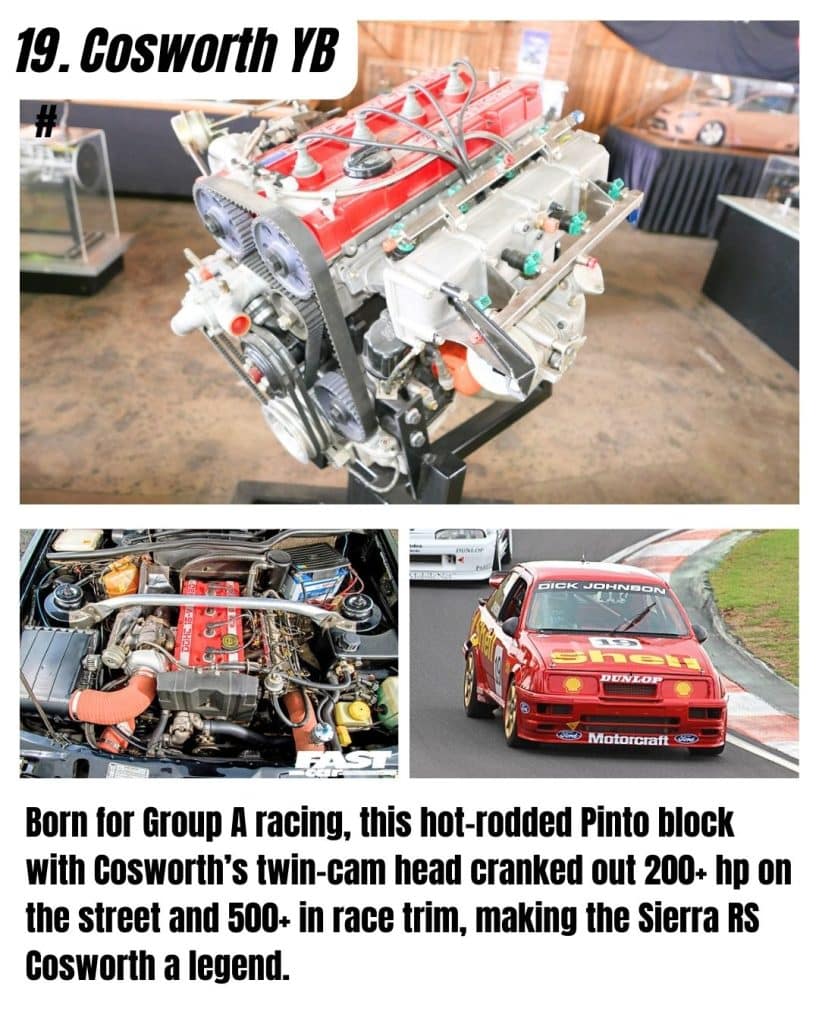
The Cosworth YB proved that a four-cylinder could carry Ford’s global performance. Born in the 1980s for rally homologation, the 2.0-liter turbo was a Pinto block topped with Cosworth’s twin-cam, 16-valve head.
In street trim, the Sierra RS Cosworth packed 204 hp, shredding tires and humiliating bigger cars. Race versions hit 370+ hp, while the RS500 exceeded 550 hp, crushing European touring car fields.
With its iron block and forged internals, the YB easily handles 500+ hp under boost. Compact, furious, and rally-bred, it remains one of Ford’s most legendary turbo icons.
18. Ford Barra 4.0 Turbo I6

The Aussie Barra inline-six was Ford Australia’s secret weapon from 2002–2016, earning the nickname “Aussie 2JZ.”
This 4.0-liter DOHC turbo six powered Falcon sedans and made 320–436 hp stock, enough to chase down V8s with ease.
What set the Barra apart was its iron block and insane tuning potential. On stock internals, gearheads pushed them to 800, 1000, even 1200 hp, turning everyday Falcons into dragstrip killers. With just a tune and bigger turbo, a humble taxi could smoke a GT Mustang.
Falcon XR6 Turbos became cult heroes, loved for spool-happy torque and a wild, buzzing exhaust note. Today, the Barra is a modern Ford legend, so good that American hot-rodders import them for swaps — because who wouldn’t want a six that can embarrass supercars?
17. Ford 7.3 “Godzilla” V8

In 2020 Ford went old-school with the 7.3-liter “Godzilla” V8, a big-block throwback for modern Super Duty trucks. This iron-block pushrod motor makes 430 hp and 485 lb-ft, modest on paper but built for grunt and longevity.
Enthusiasts quickly saw its aftermarket potential. With beefy internals and a roomy cam-in-block design, Godzilla swallows boost with ease. As a crate engine, it’s practically an invitation to hot-rodders — bolt on turbos or a blower and you’re looking at 1,000+ hp without drama.
Now showing up in vintage Mustangs, Fox-body drag cars, and off-road rigs, Godzilla is proof the classic pushrod V8 still has thunder. It’s a burly, old-fashioned motor designed for 200,000+ mile durability, yet just a cam swap away from strip-shredding power.
16. Ford 2.3L Turbo Inline-4 (Lima)
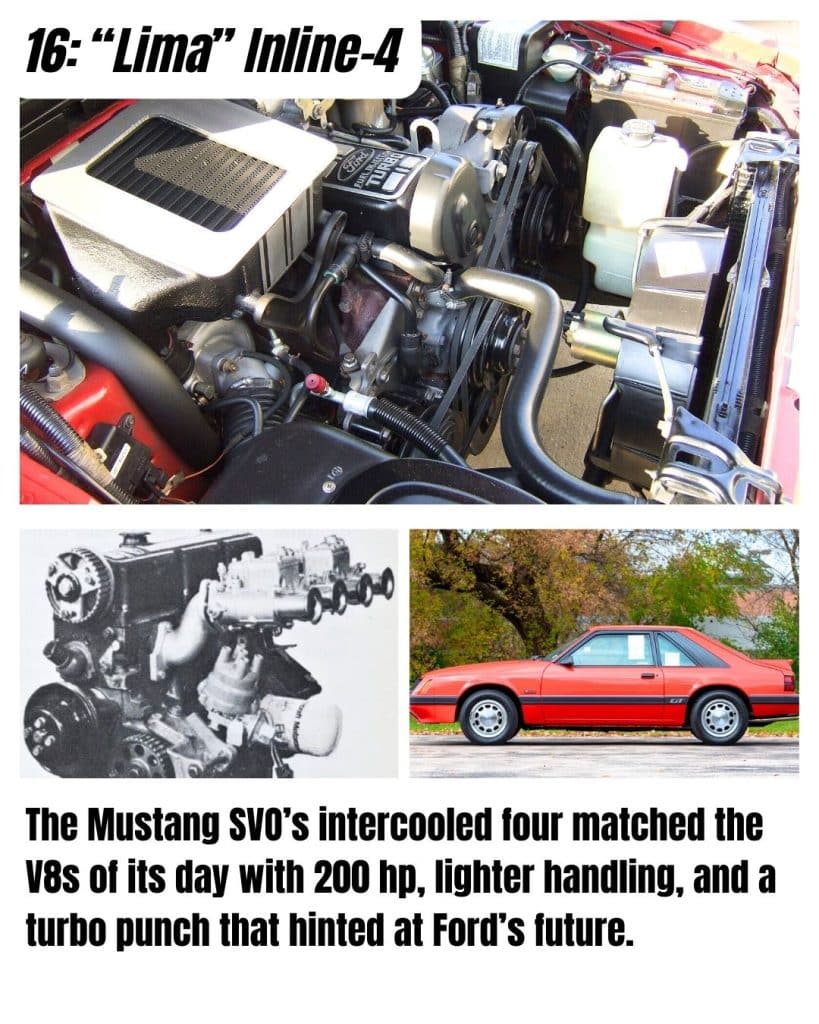
In the mid-1980s, Ford shocked purists by giving the Mustang a 2.3-liter turbo four instead of relying solely on V8 power.
The Mustang SVO (1984–1986) packed an intercooled, fuel-injected motor making 175–205 hp, enough to match the 5.0 V8 and beat it 0–60.
The lighter engine improved handling and fuel economy, yet still delivered a proper turbo punch. Born from the humble Lima pushrod design used in postal vans and Pintos, this overachiever proved durable and surprisingly quick.
It even had IMSA racing pedigree, with similar turbos running in prototypes. While controversial at launch, the 2.3 Turbo is now seen as an ’80s underdog ahead of its time, foreshadowing today’s EcoBoost Mustangs and reminding us displacement isn’t everything.
15. Ford 3.5L EcoBoost V6

When Ford gave the F-150 a twin-turbo V6 in 2011, purists scoffed. But the 3.5 EcoBoost quickly silenced doubters, delivering 400+ hp and 500+ lb-ft in later versions with V6 efficiency.
It has become the backbone of Ford’s truck lineup, proving turbos could replace cylinders without losing capability.
This engine also has a serious racing pedigree. A tuned EcoBoost powered the 2017 Ford GT to 647 hp and a class win at Le Mans 2016, exactly 50 years after the GT40’s V8 triumph. Ford’s little V6 had gone toe-to-toe with Ferrari — and won.
In daily duty, EcoBoost F-150s show durability and broad torque, making heavy trucks feel light on their feet.
It may lack a V8 rumble, but with its mix of innovation, strength, and versatility, the 3.5 EcoBoost has earned its spot as one of Ford’s all-time greats.
14. Ford 5.0L H.O. V8 (High Output 302)
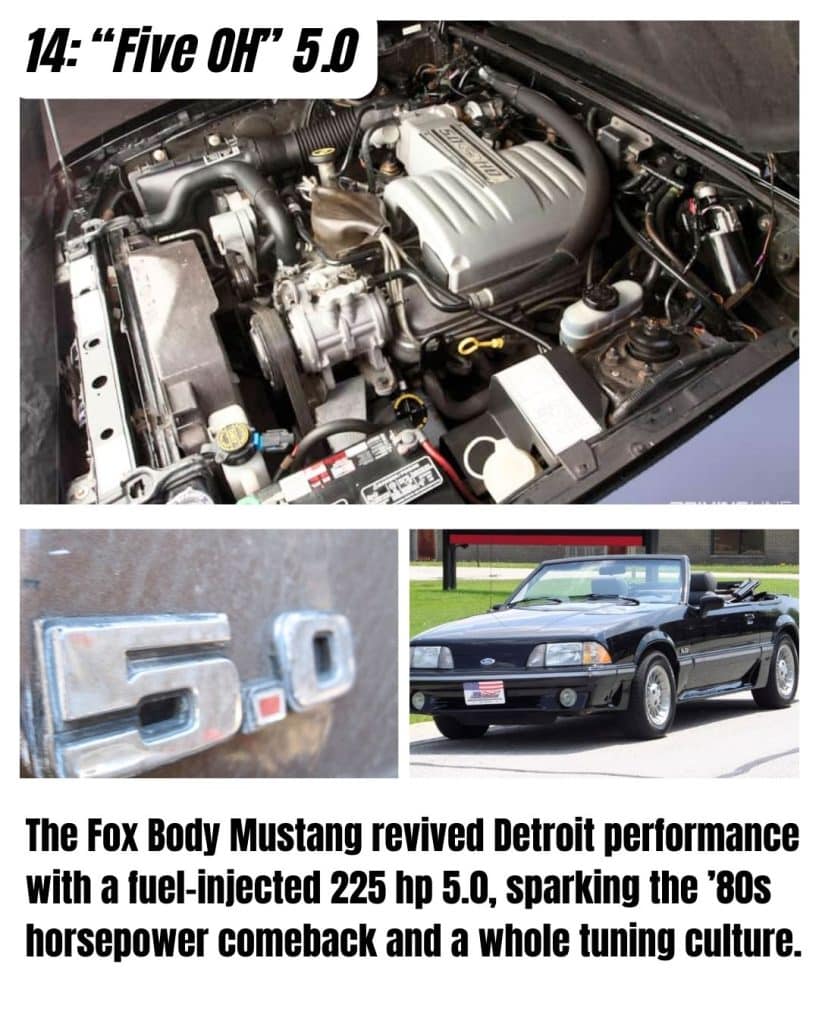
By the early ’80s, the muscle car looked dead — until Ford revived the 5.0 High Output V8 in the 1982 Mustang GT. A hotter version of the classic 302, it started with 157 hp, but Ford kept improving it. By 1987 fuel injection brought 225 hp, sparking a real Mustang comeback.
The Fox Body 5.0 quickly became an icon of the era. With “5.0” badges, magazine covers, street races, and even rap lyrics, it defined affordable performance. The torquey small-block paired with the lightweight Fox platform was a perfect recipe for speed.
Even better, the 5.0 H.O. loved mods — heads, cams, superchargers — launching the whole 5.0 tuner movement.
Civil enough for daily use yet rowdy at full throttle, it reignited the horsepower wars and cemented the Mustang as the definitive ’80s muscle machine.
13. Ford 460 “Lima” V8
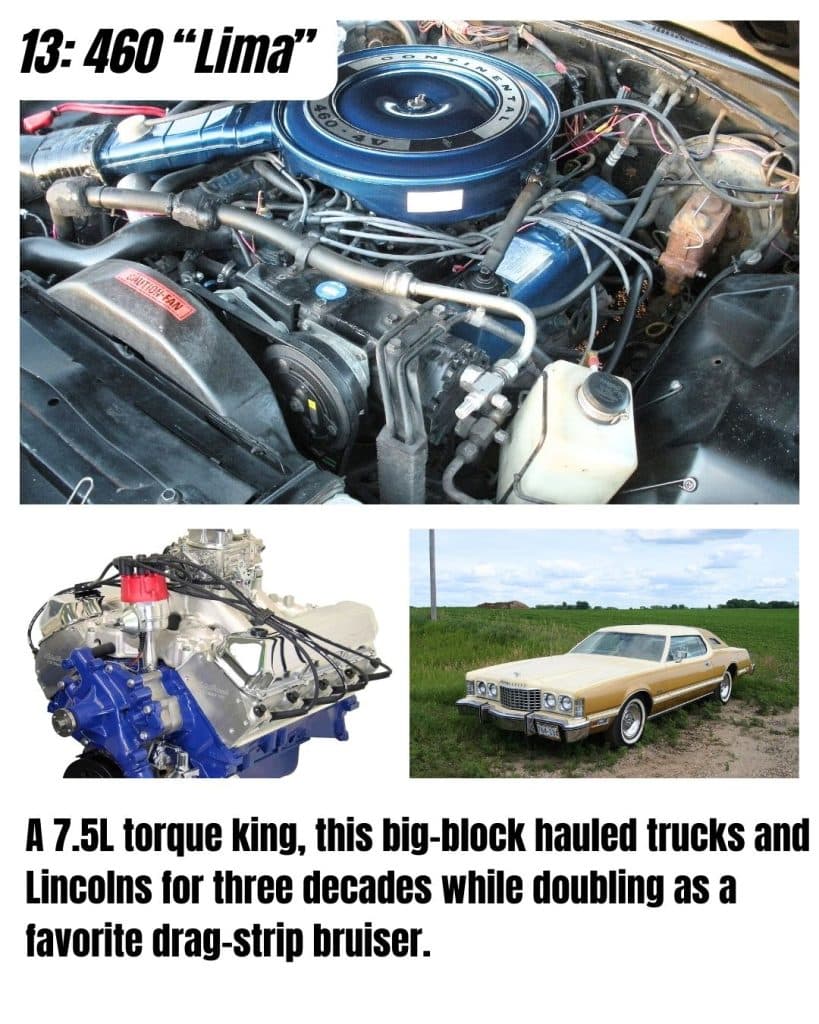
The 460 cubic-inch (7.5L) Lima V8 had one of the longest runs of any Ford big-block, powering cars and trucks from 1968 to 1997.
In its early high-compression form, it produced 365 hp and 485 lb-ft of torque, enough to pull down a house.
Even when emissions cut output, the 460’s sheer displacement kept it a towing and hauling favorite. It powered Lincolns, Mercury muscle cars, and heavy-duty Fords, always delivering mountains of low-end grunt.
Beloved because it’s virtually unkillable, the 460 could haul a 3/4-ton pickup for 200k+ miles, or with hot-rod parts crank 500+ hp with ease.
Staying in production for nearly 30 years, it proved that sometimes the answer really is just more cubic inches.
12. Ford 351 Cleveland V8
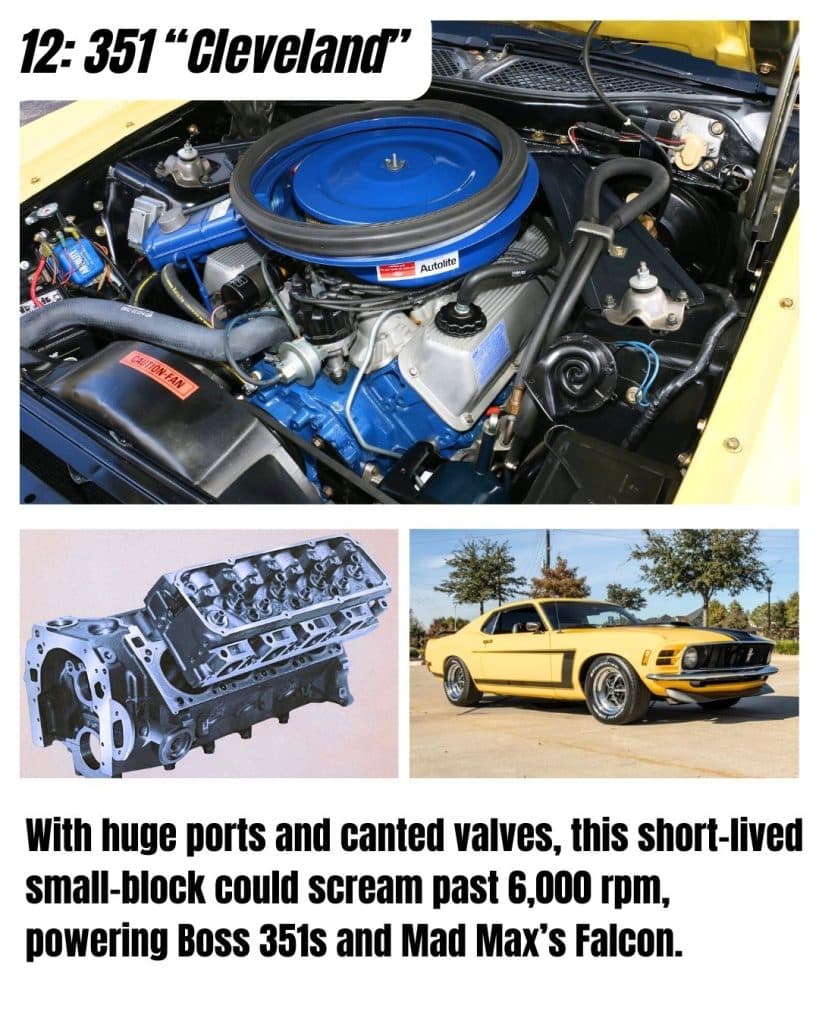
The 351 Cleveland (1970–74) was a high-performance 5.8L V8 that bridged Ford’s small- and big-blocks.
With huge, high-flow cylinder heads and canted valves, it breathed like a big-block, giving mid-size displacement serious punch. In Boss 351 trim, it made 330 hp and revved past 6,000 RPM, shocking larger rivals.
Its racing success was so potent that sanctioning bodies kept handicapping or banning it, fueling its legend as one of the most outlawed engines in racing.
On the street, it powered icons like the Boss 351 Mustang, Mach 1, Mercury Cougars, and even Aussie Falcons — including the Mad Max Pursuit Special.
Enthusiasts love the Cleveland’s brutish power and high-RPM appetite. Though its oiling system was finicky, hot-rodders solved it long ago. Short-lived yet unforgettable, the 351C remains a semi-mythical Ford V8, perfect for a snarling, period-correct street shaker.
11. Ford 300 Inline-Six
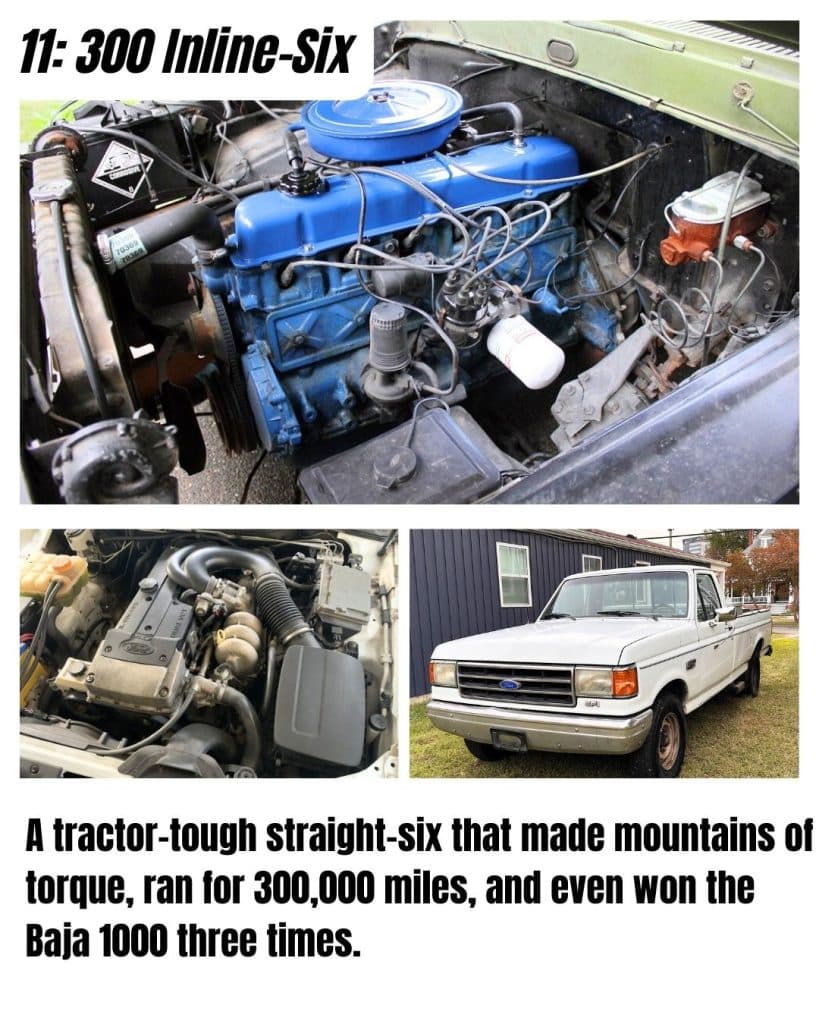
The 300 cubic-inch inline-six (4.9L), launched in 1965, became legendary for its torque and toughness.
It powered F-150s, Broncos, tractors, and generators for over 30 years, finally retiring in 1996. Most made under 150 hp, but their low-end pull made them feel unstoppable.
This engine was nearly unkillable — many ran 300,000+ miles with little more than oil changes. It hauled campers, plowed fields, and towed boats without complaint, earning a reputation as Ford’s faithful workhorse.
The 300 also has a cult following among hot rodders. Turbo builds have shocked V8s, and one even won the Baja 1000 three times, proving this humble six could outlast anything.
10. Ford 5.2L “Predator” Supercharged V8

The 5.2L Predator V8, unleashed in the 2020 Mustang Shelby GT500, is the most powerful production engine in Ford history.
With 760 hp and 625 lb-ft, it rockets the GT500 to 0–60 in just over 3 seconds, backed by a roar that shakes the pavement.
Essentially a supercharged take on the 5.2 Voodoo, the Predator swaps in a cross-plane crank for durability and that classic V8 rumble.
It’s 2.65L Eaton blower crams in 12 psi, feeding forged internals, high-flow heads, and dual-fuel injection.
The result? A motor that’s factory reliable yet exotic-crushing, equally at home on the drag strip or road course. It turned the GT500 into a Hellcat-hunting, ZL1-crushing monster, the pinnacle of Ford’s supercharged muscle.
9. Ford 5.2L “Voodoo” V8 (Flat-Plane Crank)
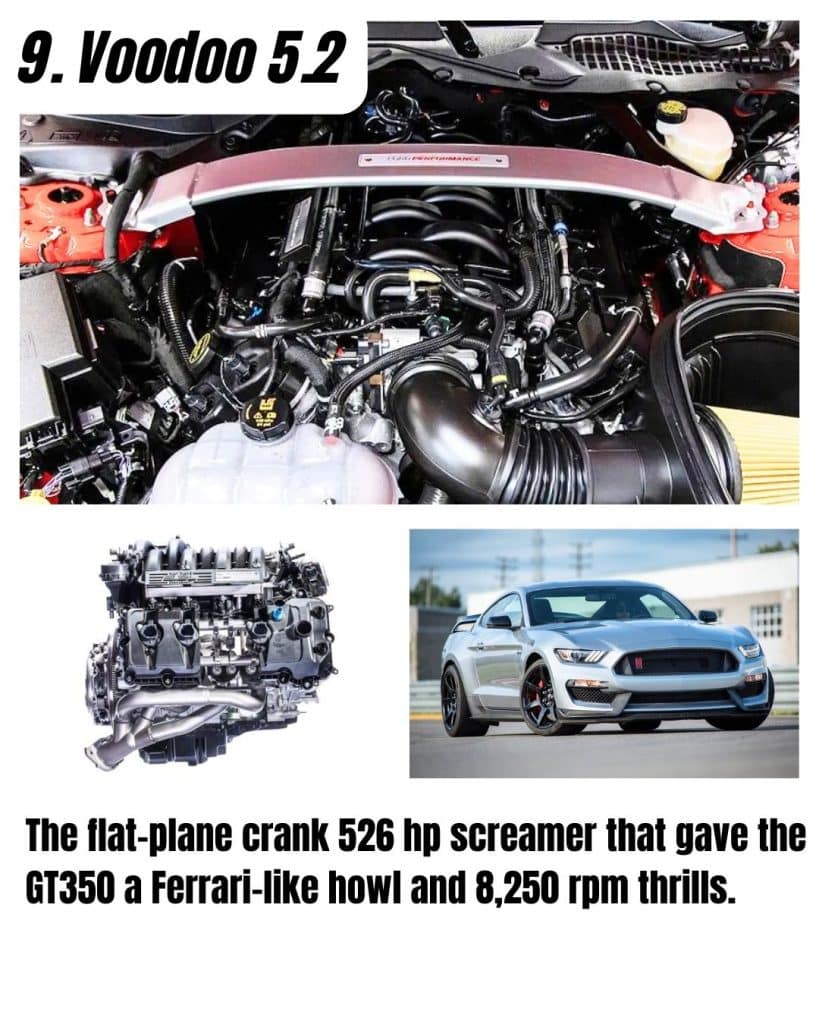
In 2015, Ford gave the Mustang GT350 a 5.2L flat-plane crank V8, a design usually reserved for Ferraris.
The result was the Voodoo V8, a high-revving screamer that made 526 hp and spun to 8,250 RPM without a whiff of forced induction.
What set it apart was its sound and character. The Voodoo’s piercing, rapid-fire howl gave enthusiasts chills, while its flat-plane design let it rev faster and breathe deeper than any Detroit V8 before it.
It wasn’t just about power — it was about personality. Lumpy at idle, ferocious past 4,000 rpm, the Voodoo made the GT350 one of Ford’s most immersive, collectible modern muscle cars.
8. Ford Boss 302 V8 (1969–70)
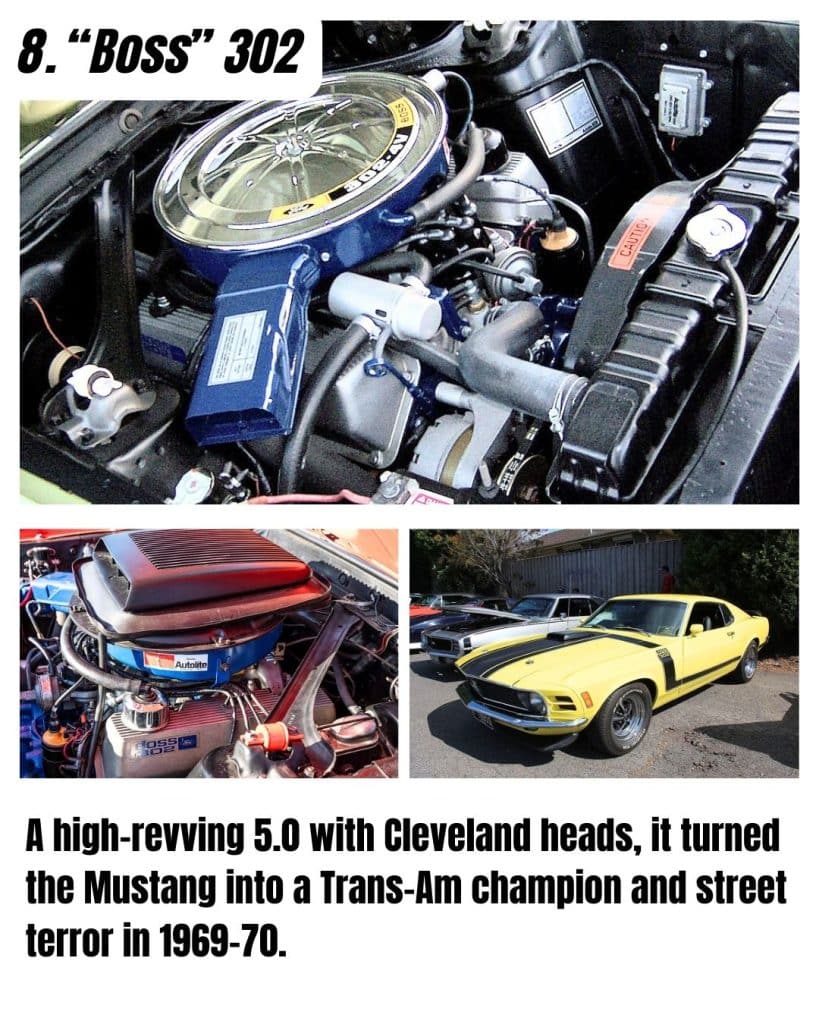
The Boss 302 turned the Mustang into a Trans-Am legend. Debuting in 1969, Ford took its 302 small-block and added Cleveland-style heads, solid lifters, and a Holley 4-barrel, creating a high-revving 5.0 that was officially rated at 290 hp but actually made well over 300.
This lighter, rev-happy motor transformed the Mustang’s balance and agility, letting it corner with Camaros and ’Cudas. In 1970, Boss 302 Mustangs captured the SCCA Trans-Am championship, cementing the engine’s reputation on track.
On the street, it demanded skill to keep in the powerband but rewarded drivers with ferocious performance. With its shaker scoop and finned valve covers, it looked the part too. Revered today, the Boss 302 proved that a small-block could be a muscle car giant-killer.
7. Ford 5.4L Supercharged V8 (Ford GT & Shelby GT500)

The 5.4L DOHC supercharged V8 was the peak of Ford’s Modular era, powering both the 2004–06 Ford GT and the Shelby GT500.
In the GT, a roots blower pushed it to 550 hp and 500 lb-ft, good for 205 mph and Ferrari-busting performance.
Built with aluminum block, dry-sump oiling, and beefy internals, it could handle 700+ hp with simple mods. SVT carried it into the 2007 GT500, later enlarging it to 5.8L “Trinity” form with 662 hp, making it the most powerful Mustang of its time.
With brutal torque, blower scream, and bulletproof strength, this engine gave everyday enthusiasts a taste of supercar performance.
It paved the way for the Predator but remains the trailblazing Modular V8 that proved supercharging was the answer.
6. Ford 428 Cobra Jet V8
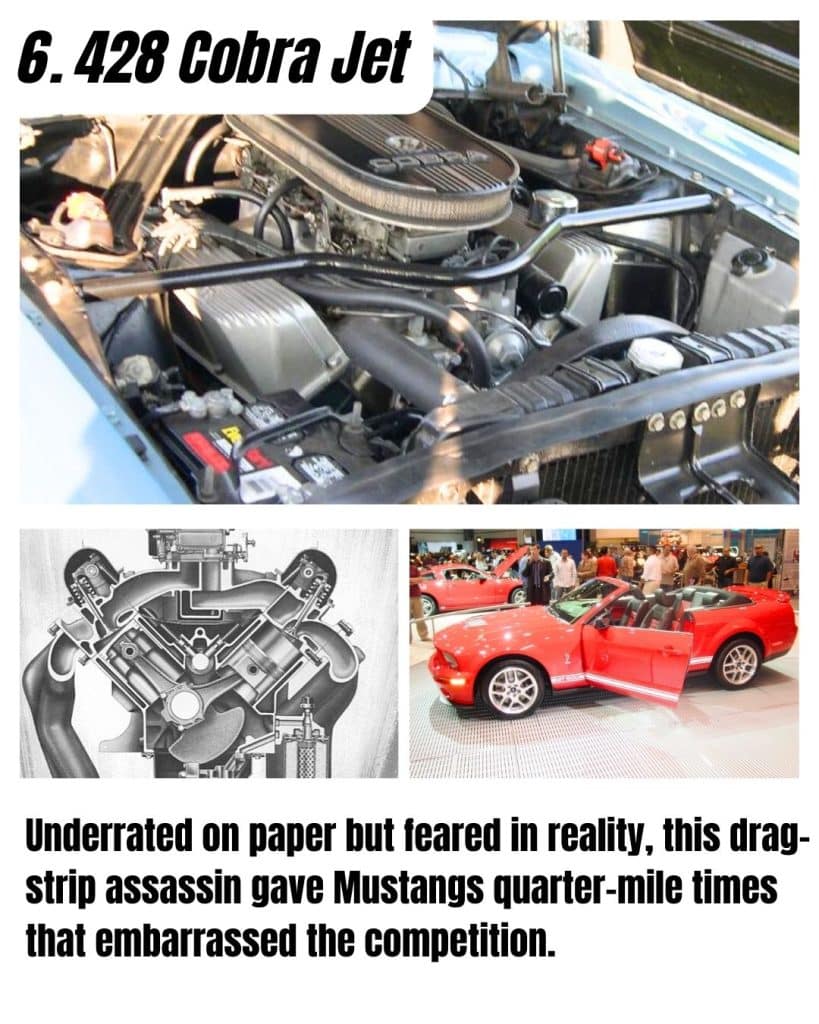
In 1968, Ford unleashed the 428 Cobra Jet, a big-block built by blending the 428’s size with 427 race parts.
Dropped into Mustangs, it was officially rated at 335 hp, but real output topped 400+ hp with massive torque.
The engine’s debut was legendary: a fleet of CJ Mustangs stormed the NHRA Winternationals, running 11–12 second quarter miles at 115+ mph, shocking rivals and proving Ford was back on top.
With ram-air induction, a big Holley carb, and a drag pack “Super Cobra Jet” option, it became Detroit’s ultimate street weapon.
Today, R-code CJ Mustangs are blue-chip collectibles, and the engine remains one of the most feared Ford big-blocks ever built.
5. Ford Boss 429 V8
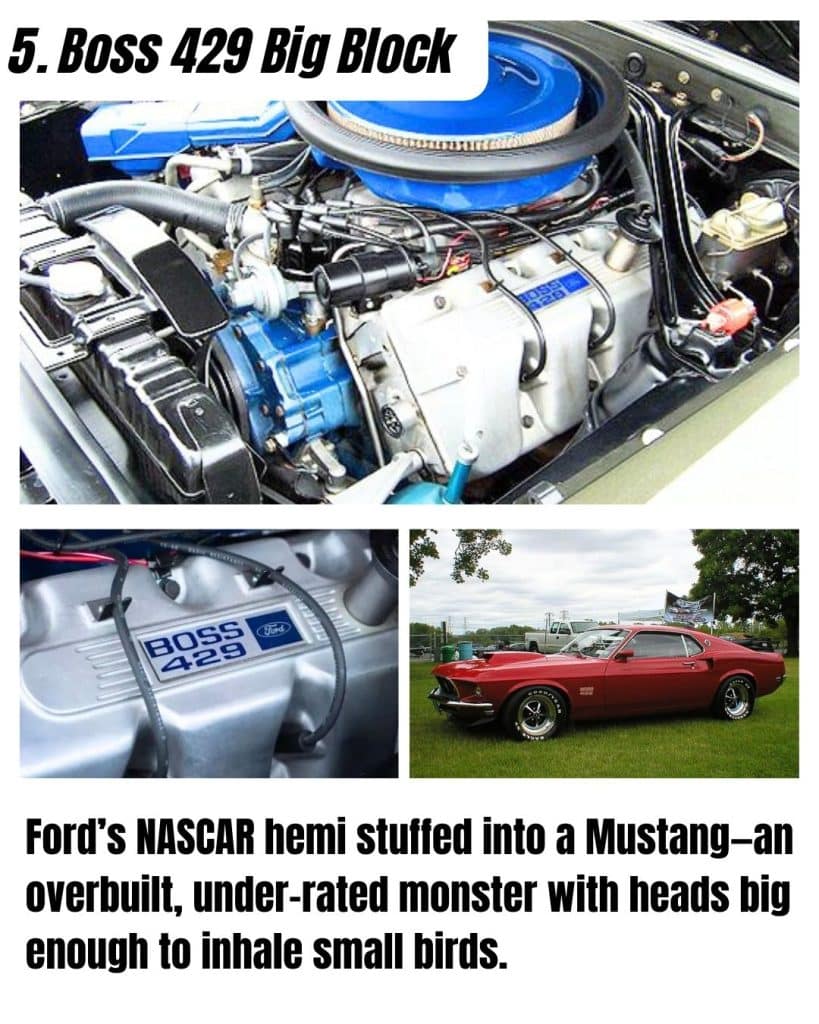
The Boss 429 was Ford’s ultimate “no replacement for displacement” engine.
Built in 1969 for NASCAR homologation, this 429 cubic-inch semi-hemi V8 featured cavernous ports and chambers, essentially a detuned racing motor stuffed into Mustang fastbacks. Kar Kraft had to rework the engine bay just to make it fit.
Ford rated it at 375 hp, but with minor tweaks a Boss 9 could top 500 hp. Though less torquey than the 428 Cobra Jet, its top-end charge was ferocious, and the mystique of its massive heads and twisted-hemi design was unmatched.
With only 1,300 built, the Boss 429 became one of the rarest, most fearsome muscle car engines.
Its gigantic hood scoop and fender badges warned onlookers this was no ordinary Mustang — it was Ford’s most audacious V8 of the golden age.
4. Ford 289/302 Windsor V8 (Small Block)
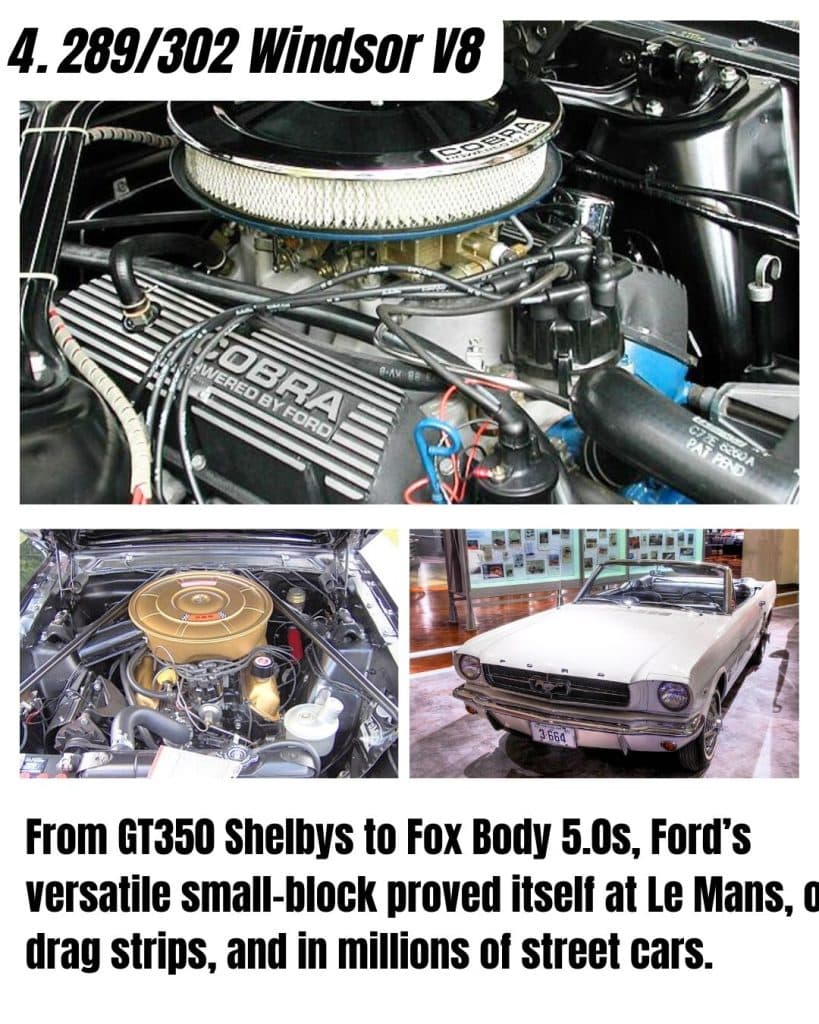
The 289/302 Windsor was Ford’s beloved small-block V8, debuting in the early ’60s and powering Mustangs, Fairlanes, F-100s, and more for over 30 years.
In Hi-Po 289 trim, it made 306 hp in the ’65 Shelby GT350 and even powered the first Cobra roadsters.
By 1968, it evolved into the 302 (5.0L), a compact, rev-happy V8 that fit in almost anything. From pony cars to luxury sedans, it was durable, easy to maintain, and endlessly adaptable for hot rodders and kit cars alike.
On track, the 289 helped the GT40 win Le Mans in 1968–69, while on the street it became the backbone of the ’80s 5.0 revival.
Reliable, versatile, and iconic, the Windsor small-block remains one of Ford’s greatest and most influential engines.
3. Ford 5.0L Coyote V8
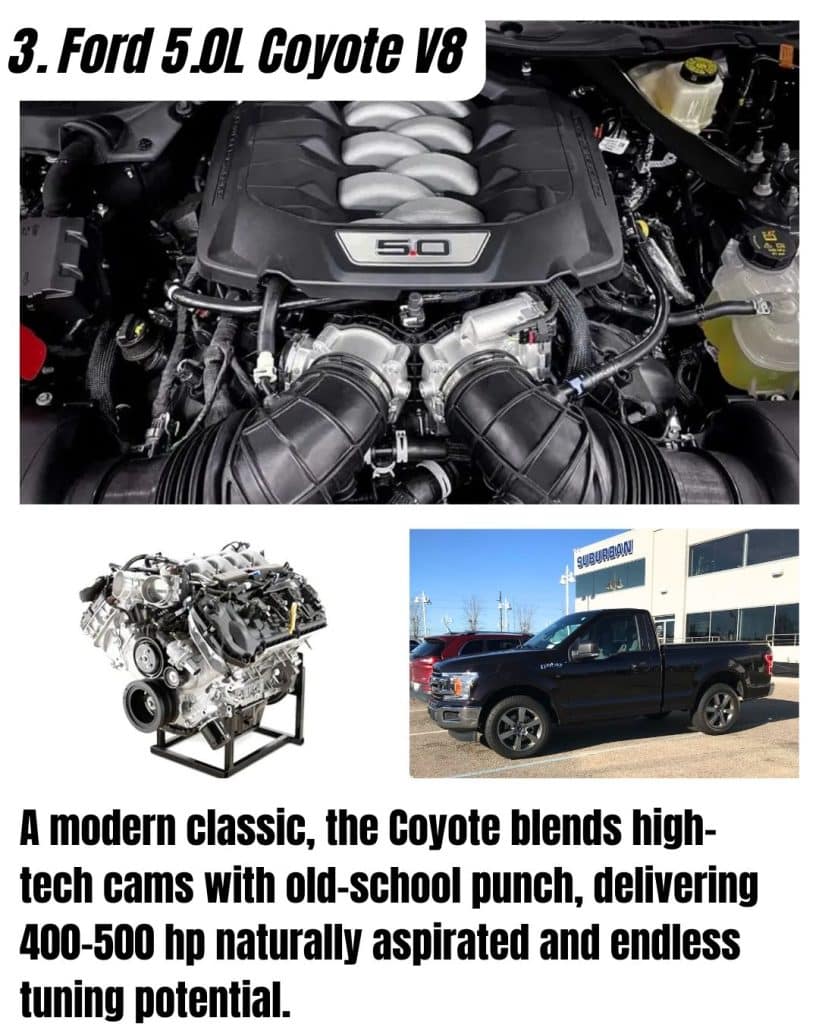
The 5.0L Coyote V8, launched in 2011, was a modern greatest-hits small-block. With aluminum construction, twin variable cam timing, and 7,000 RPM redline, it made 400+ hp while staying smooth and efficient, bringing the Mustang roaring back into the horsepower wars.
Built tough, the Coyote thrives on mods — superchargers or turbos easily push 700+ hp, while crate versions power restomods and kit cars.
Ford even fit it into the F-150, keeping the V8 heartbeat alive in America’s best-selling truck.
Now in its 4th generation, the Coyote makes 500 hp naturally aspirated in the Mustang Dark Horse.
With its crisp throttle response, broad torque, and unmistakable V8 soundtrack, it’s become one of Ford’s greatest engines of all time.
2. Ford 427 FE V8 (Side-Oiler)

The 427 FE big-block is one of Ford’s most legendary racing engines, a 7.0-liter bruiser built in the 1960s to win at every level.
It powered the GT40 to a 1-2-3 sweep at Le Mans in 1966, humbled Ferrari, and also appeared in Thunderbolt drag cars, NASCAR stockers, and Shelby Cobras.
With a high-nickel iron block, cross-bolted mains, and the “side-oiler” oiling system, it was brutally strong. In race tune, 427s made 500–600 hp and screamed to 7,000 rpm, while street versions were “rated” at 425 hp but delivered far more.
Rare and expensive, the 427 became a blue-chip engine, feared on the street and revered at the track.
From Daytona to Le Mans, it gave Ford the world-class credibility it craved and remains the company’s most mythical big-block.
1. Ford Flathead V8 (Flathead 221/239)
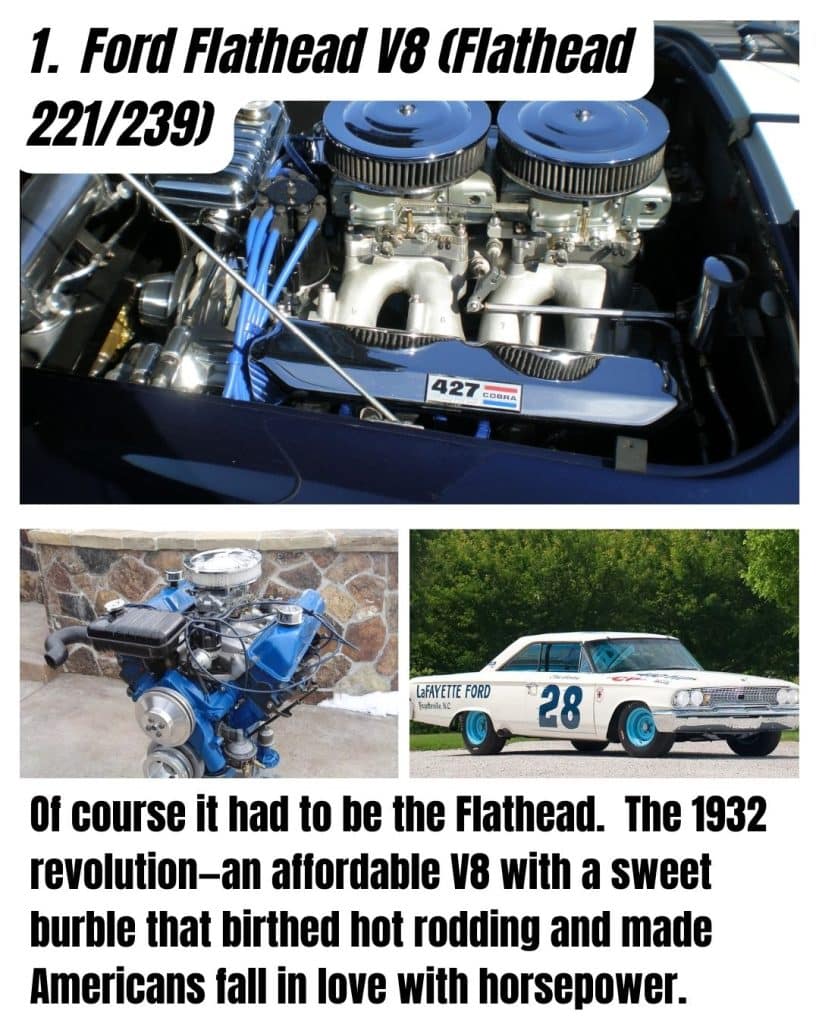
The Flathead V8, launched in 1932, was the first mass-produced, affordable V8, forever changing the auto industry.
The 221-cubic inch engine made 65 hp (later over 100), and for the price of a Ford sedan, anyone could experience smooth V8 power.
Its distinctive burbling exhaust became the soundtrack of early hot rodding. After WWII, veterans scooped up cheap Flathead Fords, turning them into drag racers, salt-flat cars, and customs.
With simple tuning and plentiful parts, the Flathead became the foundation of hot rod culture.
Though replaced by overhead-valve V8s in the ’50s, the Flathead’s impact is unmatched. It made America fall in love with the V8, and enthusiasts still celebrate it today with triple carbs, finned heads, and chrome nostalgia.
Thanks for reading!
How right or wrong do you think this list is? Let us know in the comments!
